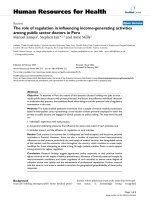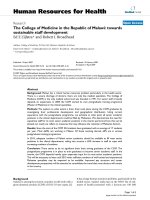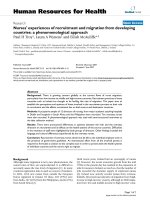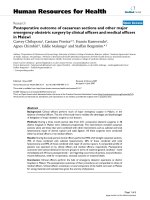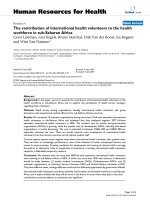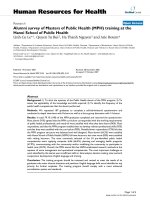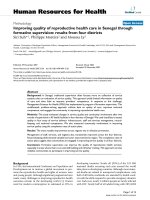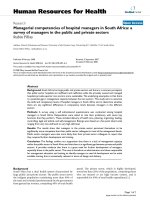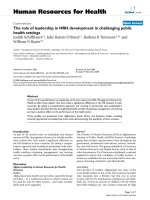Báo cáo sinh học: " Persistent expression of chemokine and chemokine receptor RNAs at primary and latent sites of herpes simplex virus 1 infection" pptx
Bạn đang xem bản rút gọn của tài liệu. Xem và tải ngay bản đầy đủ của tài liệu tại đây (402.26 KB, 12 trang )
BioMed Central
Page 1 of 12
(page number not for citation purposes)
Virology Journal
Open Access
Research
Persistent expression of chemokine and chemokine receptor RNAs
at primary and latent sites of herpes simplex virus 1 infection
W James Cook
1,2
, Martha F Kramer
3,4
, Russell M Walker
1
, Timothy J Burwell
1
,
Holly A Holman
4
, Donald M Coen
3
and David M Knipe*
4
Address:
1
Millennium Pharmaceuticals Inc., Cambridge, MA 02139, USA,
2
GlycoFi, Inc., 21 Lafayette Street, Suite 200, Lebanon, NH 03766, USA,
3
Department of Biological Chemistry and Molecular Pharmacology Harvard Medical School, Boston, MA 02115, USA and
4
Department of
Microbiology and Molecular Genetics, Harvard Medical School, Boston, MA 02115, USA
Email: W James Cook - ; Martha F Kramer - ; Russell M Walker - ;
Timothy J Burwell - ; Holly A Holman - ; Donald M Coen - ;
David M Knipe* -
* Corresponding author
Abstract
Inflammatory cytokines and infiltrating T cells are readily detected in herpes simplex virus (HSV)
infected mouse cornea and trigeminal ganglia (TG) during the acute phase of infection, and certain
cytokines continue to be expressed at lower levels in infected TG during the subsequent latent
phase. Recent results have shown that HSV infection activates Toll-like receptor signaling. Thus,
we hypothesized that chemokines may be broadly expressed at both primary sites and latent sites
of HSV infection for prolonged periods of time. Real-time reverse transcriptase-polymrease chain
reaction (RT-PCR) to quantify expression levels of transcripts encoding chemokines and their
receptors in cornea and TG following corneal infection. RNAs encoding the inflammatory-type
chemokine receptors CCR1, CCR2, CCR5, and CXCR3, which are highly expressed on activated
T cells, macrophages and most immature dendritic cells (DC), and the more broadly expressed
CCR7, were highly expressed and strongly induced in infected cornea and TG at 3 and 10 days
postinfection (dpi). Elevated levels of these RNAs persisted in both cornea and TG during the latent
phase at 30 dpi. RNAs for the broadly expressed CXCR4 receptor was induced at 30 dpi but less
so at 3 and 10 dpi in both cornea and TG. Transcripts for CCR3 and CCR6, receptors that are not
highly expressed on activated T cells or macrophages, also appeared to be induced during acute
and latent phases; however, their very low expression levels were near the limit of our detection.
RNAs encoding the CCR1 and CCR5 chemokine ligands MIP-1α, MIP-1β and RANTES, and the
CCR2 ligand MCP-1 were also strongly induced and persisted in cornea and TG during the latent
phase. These and other recent results argue that HSV antigens or DNA can stimulate expression
of chemokines, perhaps through activation of Toll-like receptors, for long periods of time at both
primary and latent sites of HSV infection. These chemokines recruit activated T cells and other
immune cells, including DC, that express chemokine receptors to primary and secondary sites of
infection. Prolonged activation of chemokine expression could provide mechanistic explanations
for certain aspects of HSV biology and pathogenesis.
Published: 23 September 2004
Virology Journal 2004, 1:5 doi:10.1186/1743-422X-1-5
Received: 25 May 2004
Accepted: 28 May 2004
This article is available from: />© 2004 Cook et al; licensee BioMed Central Ltd.
This is an open-access article distributed under the terms of the Creative Commons Attribution License ( />),
which permits unrestricted use, distribution, and reproduction in any medium, provided the original work is properly cited.
Virology Journal 2004, 1:5 />Page 2 of 12
(page number not for citation purposes)
Introduction
Acute viral infections are usually cleared from the primary
site of infection by the host immune response [1], but
some viruses can persist at other sites in a latent form.
Herpes simplex virus (HSV), for example, causes a pri-
mary infection at a mucosal site, which is cleared within
7–10 days by the host immune response. HSV, neverthe-
less, enters sensory neurons and establishes a latent infec-
tion within those cells. In a mouse corneal model of HSV-
1 infection, infectious virus is detected in corneal secre-
tions and tissue for approximately 7 days [2]. Similarly,
infectious virus is detected in trigeminal ganglion (TG) tis-
sue for up to approximately 10 days [2]. Latent infection
is established by 30 days postinfection (dpi) because no
infectious virus can be detected in homogenates of TG tis-
sue at that time. HSV DNA, however, is readily detected in
latently infected TG for at least 150 dpi [3-5]. Viral gene
expression is greatly attenuated during latent infection
because the only abundant viral gene product detected is
the latency-associated transcript or LAT [6]. Nevertheless,
low levels of lytic transcripts can be detected in ganglia
latently infected with HSV [5]. Evidence of viral protein
expression is provided by the continued T cell infiltration
[7,8], elevated levels of interferon γ (IFN-γ) and TNF-α
transcripts and numbers of IL-6 expressing cells in the
ganglia, [3,9-11]. Expression of IFN-γ and TNF-α tran-
scripts persists in TG latently infected with HSV strains
unable to replicate in neurons, indicating that neither
HSV replication nor ability to reactivate are required for
persistent cytokine gene expression [3]. While CD4
+
T
cells appear to be important in immunized mice for pro-
tection against challenge virus infection [12], CD8
+
T cells
appear to be important for establishment of latent infec-
tion in mice [7]; and CD8
+
T cells specific for HSV persist
in TG for long periods of time [8]. Thus, there is evidence
for long-term immune surveillance in the ganglion during
latent infection by HSV.
Chemokines are critical for recruiting inflammatory cells
to infected tissues. Chemokine specificity is due in large
part to the cell-specific expression of their respective
receptors (reviewed in [13-15]. Inflammatory-type recep-
tors including CCR1, CCR2, CCR5, and CXCR3 are
expressed by activated T cells, macrophages, natural killer
(NK) cells, and immature (i.e. potent for antigen capture
but not antigen presentation) dendritic cells (DC), while
homostatic-type receptors including CCR7 and CXCR4
are highly expressed by resting T and B cells and mature
(i.e., antigen-presenting) DC (Table 1). In addition, recep-
tors including CCR2, CCR5 and CXCR3 are expressed on
cells (e.g. Th1 cells) specific for infection-induced inflam-
mation, while others including CCR3 and CXCR4 are on
cells (e.g., Th2 T cells) associated with allergic inflamma-
tion. Certain receptors are expressed by specific subsets of
a given cell type. For example, CCR6 is highly expressed
on Langerhans-like (CD34
+
) DC that migrate to skin, but
not on monocyte-derived DC that migrate to non-skin tis-
sues (reviewed in [14]. Acute viral infection in the mouse
corneal model system is known to induce the expression
of cytokines and chemokines in corneal tissue. Thomas et
al. [16] observed the induction of transcripts encoding
N51/KC, macrophage inflammatory protein-1 β (MIP-
1β), MIP-2 and monocyte chemotactic protein 1 (MCP-1)
and the cytokines IL-1, IL-6, IL-12, and TNF-α. Similarly,
Tumpey et al. [17] showed induction of MIP-2, MIP-1α,
and MCP-1 chemokines in the cornea during acute infec-
tion. Infection of mouse fibroblast cells by HSV induces
expression of IL-6 [18], and infection of macrophages by
HSV induces RANTES expression directly [19]. Infection
of other cell types may induce expression of other
cytokines and chemokines. Less is known about chemok-
ine expression during HSV latent infection phase. Halford
et al. [10] observed RANTES RNA expression, in addition
to RNAs for IL-2, TNF-α, IFN-γ, and IL-10, during latent
infection.
Recent studies have shown that HSV infection activates
Toll-like signaling and chemokine synthesis [20,21].
Thus, we hypothesized that HSV infection might induce
prolonged expression of a broad range of chemokines at
sites of acute and latent infection. Real-time quantitative
RT-PCR methods have facilitated studies of immune cell
RNA expression in mouse models [22,23]. We report here
the use of real-time RT-PCR to monitor RNA expression of
selected chemokine receptors and their chemokine lig-
ands during HSV infection of mouse corneal and TG tis-
sue. Our data show that RNA encoding inflammatory-
type chemokine receptors and their ligands persists in
infected corneas and TG long after infectious virus can be
detected, suggesting prolonged chemokine production
and subsequent homing of inflammatory immune cells to
these tissues. Strikingly, the data demonstrate the persist-
ent expression of chemokines and chemokine receptor
genes in the apparent absence of detectable viral produc-
tive infection transcripts in infected corneas.
Results
Development of TaqMan
®
RT-PCR assays to measure viral
and host gene expression during acute and latent infection
To monitor RNA expression of viral and host genes during
HSV infection of mice, we developed TaqMan
®
RT-PCR
assays for the quantification of transcripts from the HSV tk
and ICP0 genes and from mouse genes encoding selected
chemokine receptors and their ligands. In the real-time
PCR assay detailed in Materials and Methods, RNA iso-
lated from corneal and ganglionic tissue was used for syn-
thesis of cDNA. Primers and Taqman
®
probes for the viral
or cellular genes (Table 2) were used in real-time PCR
assays to measure the concentration of cDNA for each
transcript.
Virology Journal 2004, 1:5 />Page 3 of 12
(page number not for citation purposes)
To characterize the range over which the HSV tk and ICP0
real-time PCR assays were accurate and linear, we tested
10-fold dilutions of purified HSV genomic DNA (kind gift
of Jean Pesola) starting from 5.5 × 10
4
copies for tk and
ICP0 gene levels. The HSV tk and ICP0 primer/probe sets
gave linear amplification curves over 4 logs of template
concentrations until the limit of detection within the lin-
ear range was reached at 55 DNA copies for tk and 550
copies for ICP0 (not shown). At these limits of detection,
the threshold cycle (CT) value, which indicated the PCR
cycle at which a significant increase in amplification was
first detected, was 39.2 for tk at 55 DNA copies and 36.5
for ICP0 at 550 DNA copies.
Using 2-fold dilutions of uninfected mouse TG cDNA, we
observed that the primer/probe sets for host genes listed
in Table 2 including GAPDH gave linear amplification
curves over at least 3 and up to 7 dilutions. In all cases, CT
values changed by about 1 cycle for every 2-fold change in
template concentration as expected (not shown). Thus
our assays matched well with previously described
TaqMan
®
assays [22-24] for linearity and sensitivity.
Following corneal inoculation of mice with HSV or virus
diluent (mock), we collected corneas and TG during acute
(3 and 10 dpi) and latent (30 dpi) phases. To monitor
viral gene expression in infected mice, we tested tissue
Table 1: Expression of Chemokine Receptors, Chemokines and Cytokines in Leukocyte Populations
Chemokine
receptors
Cell type expression Chemokine ligand Proposed primary function(s)
CCR1 T cells, macrophages, immature dendritic
cells (DC), natural killer cells (NK)
RANTES; MIP-1α; MCP-3, and 4; HCC-1,
2, and 4
Migration of DC to sites of inflammation
Recruitment of T cells, macrophages and
NK
CCR2 T cells, natural killer cells (NK),
macrophages, immature DC
MCP-1, 3, and 4 Migration of effector T cells (Th1)
Migration of DC progenitors to sites of
inflammation
CCR3 eosinophils, basophils, T cells eotaxin-1 and 2; RANTES; MCP-2, 3, and
4; HCC-2
Recruitment of eosinophils
CCR5 T cells (Th1, Tc1), macrophages,
immature DC
RANTES; MIP-1α and 1β Migration of effector T cells (Th1)
Migration of DC to sites of inflammation
Recruitment of macrophages
CCR6 immature DC (CD34+/Langerhans-like), T
cells
MIP-3α Migration of DC to skin
CCR7 T cells, B cells, mature DC SLC, ELC Migration of naïve T cells to lymph nodes
Migration of memory T cells to lymphoid
tissue
Migration of B cells Migration of DC to
lymphoid tissues
CXCR3 T cells (Th1, Tc1) IP-10, MIG, ITAC Migration of effector T cells (Th1)
CXCR4 T cells, macrophages, DC, B cells, others
including neurons
SDF-1 Migration of effector T cells (Th2)
Migration of B cells
Migration of hematopoietic progenitors
Chemokines Receptor
MIP-1α T cells, NK, macrophages, others CCR1, CCR5 Chemoattract macrophages, T cells, NK,
and others
MIP-1β T cells, NK, macrophages, others CCR5, CCR1 (weak) Chemoattract macrophages, T cells, and
others
RANTES T cells, NK CCR1, CCR5, CCR3 (weak) Chemoattract T cells and others
MCP-1 macrophages, others CCR2 Chemoattract macrophages, T cells, NK,
and others
Eotaxin-1 epithelial cells, NK, macrophages, others CCR3 Chemoattract eosinophils
Cytokines Receptor
IFN-γ T cells, NK IFN-γR Activation of antiviral response
TNF-α macrophages, NK, others TNF-R Broad activation of antiviral and
inflammatory response
Virology Journal 2004, 1:5 />Page 4 of 12
(page number not for citation purposes)
samples for tk and ICP0 gene transcripts. In infected cor-
neal tissue, HSV tk and ICP0 transcripts were readily
detected at 3, but not at 10 or 30 dpi where CT values = 40
(indicating no measurable RNA) (Fig. 1). Thus we could
not detect lytic transcripts in infected corneas beyond the
acute phase using this assay.
In infected TG, tk RNA peaked at 3 dpi then dropped pre-
cipitously (200-fold) to low but readily detectable levels
by 10 dpi. At 30 dpi, we detected very low or undetectable
tk RNA expression in infected TG. In the experiment
shown in Fig. 1A, we measured a CT value of 38.2 for tk
expression in infected TG at 30 dpi, resulting in a relative
expression value of 0.0002. In an independent experi-
ment, we measured a CT of 38.1 for tk RNA in 30 dpi TG;
however, a CT value of 40 was measured in two additional
experiments (not shown). CT values for all reactions with-
out RT were 40, indicating no DNA contamination. Thus,
while tk expression in latent TG was at the limit of detec-
tion for our assay, our ability to detect tk expression in
some but not all latent TG was consistent with previous
reports in which very sensitive RT-PCR assays were used to
detect tk (and ICP0) gene transcripts in some but not all
TG during latent infection [5,25]. In those previous
reports, an assay that included a radioactive Southern
blotting step subsequent to RT-PCR could detect single
copies of tk nucleic acid per PCR reaction. Our present
assay for tk transcripts is at least 50-fold less sensitive than
that used by Kramer and Coen [5].
ICP0 RNA levels were similar to tk in that they peaked at
3 dpi in cornea and TG (Fig. 1B). However, because our
ICP0 probe/primer set overlaps latency-associated tran-
script minor (LAT) – coding sequences, the signal detected
at 10 and 30 dpi in TG but not cornea may be due to
minor LAT read-through RNAs. RT-PCR analysis of LAT
transcripts from the TGs at 30 dpi was consistent with
latent virus in infected TG (unpublished results).
Chemokine and chemokine receptor expression in infected
cornea and ganglia
We next used TaqMan
®
RT-PCR to monitor expression of
a selected series of mostly T cell and macrophage-specific
chemokine receptors and chemokines in mock and HSV-
infected cornea and TG. We chose chemokine receptors
CCR1, CCR2, CCR5, and CXCR3, which are expressed by
activated T cells, macrophages, NK cells, and immature
DC that would be part of the immune infiltration in
response to HSV infection, and their ligands MIP-1α, MIP-
1β, RANTES, and MCP-1. For comparison, we included
CCR3 which is primarily expressed on granulocytes, the
CCR3 ligand eotaxin-1, CCR6 which is primarily
expressed on resting T cells and immature Langerhans-like
(i.e., skin homing) DCs, CCR7 which is primarily
Table 2: Primer and Probe Sequences
Forward Primer Reverse Primer Probe*
HSV
tk
CGAGACAATCGCGAACATCTAC CCCCGGCCGATATCTCA CCACACAACACCGCCTCGACCA
ICP0
CTGCGCTGCGACACCTT CAATTGCATCCAGGTTTTCATG TGCATGCACCGCTTCTGCATCC
Chemokine
receptor
CCR1
GGGTGAACGGTTCTGGAAGTAC CAGCCATTTTGCCAGTGGTA ACATGCCTTTGAAACAGCTGCCGAA
CCR2
ATGAGTAACTGTGTGATTGACAAGCA GCAGCAGTGTGTCATTCCAAGA CTCTGTCACCTGCATGGCCTGGTCT
CCR3
ACCAGCTGTGAGCAGAGTAAACAT CACAGCAGTGGGTGTAGGCA CACCTCAGTCACCTGCATGGCCA
CCR5
ACTGCTGCCTAAACCCTGTCA GTTTTCGGAAGAACACTGAGAGATAA TCCGGAACTTCTCTCCAACAAAGGCA
CCR6
TTGGTGCAGGCCCAGAAC GAACACGAGAACCACAGCGAT CCAAGAGGCACAGAGCCATCCGA
CCR7
CTGCTACCTCATTATCATCCGTACCT TGATCACCTTGATGGCCTTGT CTCCAGGCACGCAACTTTGAGCG
CXCR3
TGTAGTTGGGCTAGCTCGAACTT ACCTGGATATATGCTGAGCTGTCA GCATCCTGGCAGCAAAGTTACGGG
CXCR4
CTCCAAGGGCCACCAGAA GGCAAAGAAAGCTAGGATGAGG CGCAAGGCCCTCAAGACGACAGTC
Chemokine
MIP-1α
TCATCGTTGACTATTTTGAAACCAG GCCGGTTTCTCTTAGTCAGGAA AGCCTTTGCTCCCAGCCAGGTGTC
MIP-1β
AGGGTTCTCAGCACCAATGG GCTGCCGGGAGGTGTAAGA CTCTGACCCTCCCACTTCCTGCTGTTT
RANTES
CTGTCATCGCTTGCTCTAGTCCTA CGGATGGAGATGCCGATTT ATCCCCTACTCCCACTCCGGTCCTG
MCP-1
GCTGGGTTCAGTTTCCTTAAGC CCTAGTCTTTAGCTGTGAGACCTTCTG AGGCCTCGCTGCTCCACATCCA
Eotaxin-1
CCTAAGACGTGCTCTGAGGGAAT TCCCATCTGGAACTACATGAAGC TCAGCACCAGTCGCCCAAGGACT
Cytokine
IFN-γ
TGAGTATTGCCAAGTTTGAGGTCA GTGGACCACTCGGATGAGCT CCACAGGTCCAGCGCCAAGCA
TNF-α
ACAAGGCTGCCCCGACTAC CGCAGAGAGGAGGTTGACTT CCTCACCCACACCGTCAGCCG
* all probes FAM-5' and 3'-TAMRA
Virology Journal 2004, 1:5 />Page 5 of 12
(page number not for citation purposes)
HSV tk and ICP0 RNA expression in mock and HSV-infected cornea and TGFigure 1
HSV tk and ICP0 RNA expression in mock and HSV-infected cornea and TG. RNA isolated from tissues harvested at 3, 10, or
30 days postinfection (d) was subjected to TaqMan RT-PCR analysis using HSV tk primers/probe (A) and HSV ICP0 primers/
probe (B) as described in Materials and Methods. Mouse GAPDH RNA was measured in multiplex reactions, and used to cal-
culate relative expression using the formula Rel Exp= 2
-(∆∆CT)
× 1000 as described in Materials and Methods. Shown below the
plots are relative expression values and the CT value measured for tk (A) and ICPO (B) in each sample. The ICP0 signal detected
at 10 and 30 dpi in HSV-infected TG is likely due to LAT RNA as described in the text. Results shown are for one experiment
(Experiment #1) in which the number of individual mouse tissues pooled were 10 for cornea and 6 for TG. Similar results were
obtained in two additional experiments (Experiment #2 and Experiment #3), except for variation in detection of tk RNA in
infected TG at 30 dpi as described in the text.
A
0.0
5.0
10.0
15.0
20.0
25.0
Relative Expression
Rel express
0.0 2.1 0.0 0.0 0.0 0.0
0.0
22.1 0.0
0.1
0.0 0.0
tk CT
40.0 29.4 40.0 40.0 40.0 40.0
40.0
22.3 40.0
30.4
40.0 38.2
GAPDH CT
21.6 20.5 20.1 19.5 19.6 20.4
17.0
16.8 16.9
17.0
16.0 16.2
Mock HSV Mock HSV Mock HSV Mock HSV Mock
HSV
Mock HSV
3d 10d 30d 3d 10d 30d
Cornea TG
tk expression
B
0.0
10.0
20.0
30.0
40.0
50.0
60.0
Relative Expression
Rel express
0.0 7.0 0.0 0.0 0.0 0.0
0.0
50.8 0.0 2.7 0.0 2.2
ICP0 CT
40.0 26.7 40.0 40.0 40.0 40.0
40.0
20.5 40.0 26.0 40.0 24.7
GAPDH CT
21.2 19.5 19.9 19.2 19.5 20.2
17.2
16.2 17.0 17.5 16.6 15.8
Mock HSV Mock HSV Mock HSV
Mock
HSV
Mock HSV Mock HSV
3d 10d 30d 3d 10d 30d
Cornea TG
ICP0 ex
p
ression
Virology Journal 2004, 1:5 />Page 6 of 12
(page number not for citation purposes)
expressed on resting T and B cells and mature DCs that
home back to lymphoid tissues, and CXCR4 which is
broadly expressed on many immune and non-immune
cell types (Table 1). We also tested the chemokine-induc-
ing cytokines IFN-γ and TNF-α, whose RNA and protein
have previously been shown to be expressed during both
acute and latent phases of HSV infection [3,9-11].
i. Chemokine and chemokine receptor expression in infected cornea
Epithelial cells of the cornea are the initial sites of replica-
tion following infection but infectious virus and viral
mRNAs are not detectable past 7–10 dpi [26]. We har-
vested RNA from mock and HSV-infected cornea at 3, 10,
and 30 dpi, and tested for chemokine receptor and chem-
okine RNA expression in parallel. As expected for tissues
supporting active replication or having recently cleared
virus, chemokine receptors CCR1, CCR2, CCR5, CCR7,
CXCR3 and CXCR4, but not CCR3 or CCR6, were highly
expressed and strongly induced (i.e., >3-fold) at 3 and 10
dpi (Fig. 2 and Table 3). Chemokines MIP-1α, MIP-1β,
RANTES, and MCP-1, but not eotaxin-1, were also highly
expressed and strongly induced in infected cornea at 3 and
10 dpi. IFN-γ and TNF-α were also induced in infected
cornea as previously reported [16]. Surprisingly, induc-
tion of all host RNAs tested persisted into latent phase at
30 dpi in infected corneas. For example, CCR1, CCR2, and
CCR5 exhibited similar induction and similar or only
slightly reduced expression levels at 30 dpi as compared to
earlier time points. Relative expression and induction of
CCR7 and CXCR4 in infected cornea appeared to be
biphasic in that values were high at 3, lower at 10, and
higher again at 30 dpi. These results suggested that contin-
ued presentation of HSV antigens stimulates chemokine
production and subsequent homing of effector cells to
cornea despite the apparent clearance of infectious virus.
ii. Chemokine and chemokine receptor expression in infected ganglia
In infected TG, transcripts from the genes encoding recep-
tors CCR1, CCR2, CCR5, CCR7, and CXCR3 were induced
by HSV infection during both acute (3 and 10 dpi) and
latent (30 dpi) phases (Fig. 3 and Table 3). Peak induction
of these RNAs was at 10 dpi during the clearance phase.
CXCR4 was induced at 10 and 30 dpi but not at 3 dpi.
While we measured induction of CCR3 and CCR6 at 10
and 30 dpi, their very low expression was at the limit of
our detection (i.e., relative expression values < 0.5) as also
seen in corneas. RNAs for the MIP-1α, MIP-1β, RANTES,
and MCP-1 chemokines were also strongly induced at
each timepoint, particularly at 3 dpi. Eotaxin-1 was
induced at 3 dpi, but much less so at 10 and 30 dpi. As
seen previously [3] cytokines IFN-γ and TNF-α were
strongly induced at 3 and 10 dpi, but much less so at 30
dpi.
A striking finding in this analysis was the persistent
expression of inflammatory cell RNAs during the latent
phase of TG infection when detectable production of
infectious virus has ceased. To determine if induction of
these RNAs persisted past 30 dpi, we monitored expres-
sion of a limited number of transcipts from in TG col-
lected at 45, 62, and 90 dpi. In previous studies [3-5], HSV
genomic DNA was maintained at constant levels (~10
4
copies per TG) for up to 150 dpi in infected TG, indicating
that latent virus persists well beyond 90 dpi in this mouse
model. Induction of all RNAs in our panel persisted for at
least 62 dpi; furthermore, all but CCR3 and eotaxin-1
were also induced at 90 dpi (Table 4). Thus chemokine
receptor and ligand expression persisted long into the
latent phase in infected TG.
Discussion
Recent studies have shown that HSV infection induces
Toll-like signaling and chemokine synthesis. Thus, we
hypothesized that HSV infection might induce a broad
range of chemokines at sites of primary and latent infec-
tion. In agreement with and extending previous studies
[3,9-11], we have found evidence for persistent expression
of chemokines and trafficking of inflammatory cells
including activated T cells to acutely infected corneal tis-
sue and to latently infected trigeminal ganglia. We also
observed prolonged expression of chemokine and chem-
okine receptor gene transcripts in corneal tissue, the
primary site of HSV-1 infection in this model system, long
after infectious virus has been cleared. Microarray analysis
of host gene expression has also demonstrated long-term
alterations of host gene expression during latent infection
by HSV, including alterations in expression of CXCR6
mRNA in TG [27]. These results argue for long-term per-
sistence or expression of viral antigens or immunogens
and stimulation of expression of these chemokines, even
at the primary site of infection, the cornea. Recent results
[28] have shown similar elevated chemokine expression
in lung tissue after clearance of murine gamma herpesvi-
rus 68. It will be of interest to determine how widespread
this effect is among different virus infections or whether it
is unique to viruses that persist in the host, such as the
herpesviruses.
Potential mechanisms for elevated expression of
chemokines and chemokine receptors after viral clearance
Low level expression of viral lytic transcripts in TG during
latent infection has been documented [5], which could
result in low level expression of viral proteins. Recent
results have shown that HSV-1 can activate Toll-like recep-
tor 2 to stimulate chemokine expression and secretion
and to activate NF-κB regulated promoters [20]. Lund et
al. [21] showed that infectious HSV-2 and also purified
HSV-2 DNA activates signaling through DC-expressed
Toll-like receptor 9, resulting in the induction of IFN-α
Virology Journal 2004, 1:5 />Page 7 of 12
(page number not for citation purposes)
Relative levels of chemokine and chemokine receptor RNA expression in mock and HSV-infected corneaFigure 2
Relative levels of chemokine and chemokine receptor RNA expression in mock and HSV-infected cornea. Corneas were har-
vested at 3 (A), 10 (B), or 30 (C) days postinfection, and relative levels of expression were determined by TaqMan RT-PCR anal-
ysis as described in Fig. 1 and Materials and Methods. Results shown are the average of relative expression values determined
using cDNA from two independent experiments, with each cDNA subjected to 2 or 3 separate measurements. Dashed bars
represent ranges of individual values. Each cDNA was synthesized from RNA isolated from pooled corneas (5 mice) as described
in Fig. 1 and Materials and Methods. The induction ratios (HSV+ vs. mock) for individual genes are tabulated in Table 3.
A
0.0
10.0
20.0
30.0
40.0
50.0
60.0
70.0
CCR1
CCR2
CCR3
CCR5
CCR6
CCR7
CXCR3
CXCR4
MIP-1a
MIP-1b
RANTES
MCP-1
Eotaxin-1
IFN-g
TNF-a
Relative expression
Mock
HSV+
MIP-1a
MIP-1
b
IFN-g
TNF-a
B
0.0
5.0
10.0
15.0
20.0
25.0
30.0
35.0
CCR1
CCR2
CCR3
CCR5
CCR6
CCR7
CXCR3
CXCR4
MIP-1a
MIP-1b
RANTES
MCP-1
Eotaxin-1
IFN-g
TNF-a
Relative expression
Mock
HSV+
MIP-1a
MIP-1
b
IFN-g
TNF-a
C
0.0
5.0
10.0
15.0
20.0
25.0
30.0
35.0
CCR1
CCR2
CCR3
CCR5
CCR6
CCR7
CXCR3
CXCR4
MIP-1a
MIP-1b
RANTES
MCP-1
Eotaxin-1
IFN-g
TNF-a
Relative expression
Mock
HSV+
MIP-1a
MIP-1
b
IFN-g
TNF-a
Cornea, 30dpi
Cornea, 10dpi
Cornea, 3dpi
Virology Journal 2004, 1:5 />Page 8 of 12
(page number not for citation purposes)
secretion. Toll-like receptor activation by HSV-2 DNA
raises the intriguing possibility that HSV DNA alone is at
least partially responsible for TLR-dependent induction of
chemokine expression in latent TG. Among the transcripts
that we studied, we detected persistent expression of tran-
scripts for MIP-1α, MIP-1β, and RANTES, whose expres-
sion is activated by Toll-like receptors [29]. Expression of
MIP-1α and MIP-1β could recruit NK cells, which express
CCR5, and immature dendritic cells, which express CCR1
and CCR5, into the site of infection. Thus, elevated expres-
sion of at least some of the chemokines could be due to
Toll-like receptor activation. It is also possible that other
chemokines that were not assayed in this or previous stud-
ies are also induced during latent HSV infection via Toll-
like receptor dependent mechanisms. Elevated expression
of chemokine receptors is likely due to the chemokine-
induced trafficking of inflammatory cells to the site of
infection or, in the case of 30 days postinfection or latent
infection, the site of viral antigen persistence.
Although we have not examined expression of IP-10, a
chemokine also induced by Toll-like receptor signaling
[29], we did examine the expression of transcripts for
CXCR3, its receptor on activated T cells. Levels of both are
elevated during latent infection in TG. Thus, stimulation
of expression of this chemokine could attract activated T
Table 3: Induction Ratio (HSV+/Mock) of Transcripts for Chemokine Receptors, Chemokines and Cytokines in Cornea and Trigeminal
Ganglia (TG)
Cornea
a
TG
b
Gene 3d 10d 30d 3d 10d 30d
CCR1 11 (9.2–12) 18 (13–23) 20 (10–26) 5 (2.2–7.1) 15 (9.0–19) 4 (1.7–7.0)
CCR2 14 (9.2–19) 22 (11–32) 14 (8.1–24) 3 (1.5–4.2) 15 (11–19) 3 (1.3–4.4)
CCR3 2 (1.0–5.0) 3 (2.0–5.0) 3 (2.5–3.3) 2 (0.5–5.0) 8 (2.2–20) 3 (1.8–4.7)
CCR5 12 (12.3–12.5) 11 (8.0–14) 20 (8.9–36) 9 (4.8–11) 57 (22–110) 9 (7.0–10)
CCR6 3 (2.4–3.0) 2 (1.0–2.5) 5 (1.5–8.5) 3 (0.3–11) 3 (1.0–5.0) 14 (1.0–40)
CCR7 24 (8.0–40) 5 (3.0–6.5) 17 (13–21) 13 (9.0–17) 19 (17–20) 7 (2.0–11)
CXCR3 10 (5.0–18) 15 (8.0–23) 5 (2.8–6.5) 2 (1.0–4.0) 104 (54–160) 36 (14–59)
CXCR4 11 (4.8–14) 3 (1.7–4.0) 45 (33–74) 0.6 (0.4–0.9) 4 (2.9–6.2) 3 (2.3–3.7)
MIP-1α 69 (33–106) 394 (263–1700) 34 (16–53) 232 (80–471) 126 (80–168) 25 (13–45)
MIP-1β 53 (39–67) 285 (261–310) 16 (11–21) 282 (10–595) 230 (202–245) 31 (24–37)
RANTES 55 (36–73) 43 (38–48) 16 (12–18) 64 (61–66) 304 (302–306) 31 (12–50)
MCP-1 54 (52–55) 64 (55–74) 12 (7.5–20) 153 (113–194) 22 (16–27) 3 (1.6–4.2)
Eotaxin-1 3 (1.9–3.5) 1 (0.6–1.3) 3 (1.0–5.4) 5 (3.3–9.1) 2 (1.2–2.8) 1.5 (0.7–2.3)
IFNγ Inf.
c
Inf. Inf. Inf. Inf. Inf.
TNF-α 3 (2.9–3.0) 3 (2.6–3.8) 7 (3.9–12) Inf. Inf. Inf.
a
Induction ratios were calculated as relative expression in HSV-infected/relative expression in mock-infected cornea. Each value is the average of
induction ratios (2 or 3 separate measurements per cDNA sample) from two independent experiments. Ranges of individual ratios are in
parentheses.
b
Induction ratios were calculated for HSV- vs. mock-infected TG as in footnote
a
. Each value is the average of induction ratios (2 or 3 separate
measurements per cDNA sample) from three independent experiments, with ranges in parentheses.
c
Inf., infinite due to relative expression = 0 in all or most mock-infected samples.
Virology Journal 2004, 1:5 />Page 9 of 12
(page number not for citation purposes)
Relative levels of chemokine and chemokine receptor RNA expression in mock and HSV-infected TGFigure 3
Relative levels of chemokine and chemokine receptor RNA expression in mock and HSV-infected TG. TG were harvested at 3
(A), 10 (B), or 30 (C) days postinfection, and RNA levels were determined by TaqMan RT-PCR analysis as described in Fig. 1,
Fig. 2 and Materials and Methods. Results shown are the average of relative expression values determined using cDNA from
three independent experiments, with each cDNA subjected to 2 or 3 separate measurements. Dashed bars represent ranges
of individual values as described in Fig. 2. The induction ratios (HSV+ vs. mock) for individual genes are tabulated in Table 3.
A
0.0
10.0
20.0
30.0
40.0
50.0
60.0
70.0
80.0
90.0
100.0
CCR1
CCR2
CCR3
CCR5
CCR6
CCR7
CXCR3
CXCR4
MIP-1a
MIP-1b
RANTES
MCP-1
Eotaxin-1
IFN-g
TNF-a
Relative expression
Mock
HSV+
MIP-1a
MIP-1b
IFN
-
g
TNF
-
a
TG, 3d
p
i
B
0.0
10.0
20.0
30.0
40.0
50.0
60.0
70.0
80.0
90.0
100.0
CCR1
CCR2
CCR3
CCR5
CCR6
CCR7
CXCR3
CXCR4
MIP-1a
MIP-1b
RANTES
MCP-1
Eotaxin-1
IFN-g
TNF-a
Relative expression
Mock
HSV+
385 (337-432)
MIP-1a
MIP-1
b
IFN-
g
TNF-
a
TG, 10d
p
i
C
0.0
5.0
10.0
15.0
20.0
25.0
30.0
35.0
40.0
CCR1
CCR2
CCR3
CCR5
CCR6
CCR7
CXCR3
CXCR4
MIP-1a
MIP-1b
RANTES
MCP-1
Eotaxin-1
IFN-g
TNF-a
Relative expression
Mock
HSV+
MIP-1a
MIP-1b
IFN-g
TNF-a
TG, 30d
p
i
Virology Journal 2004, 1:5 />Page 10 of 12
(page number not for citation purposes)
cells to the latently infected TG, providing a mechanism
for the persistent presence of HSV-specific CD8
+
T cells in
latently infected TG [8].
Implications of persistent chemokine expression
Long-term inflammatory responses in neural tissue could
induce pathology due to damage to neuronal cells. A
number of neurological diseases have been associated
with HSV infection [30], and these could be associated
with these long-term inflammatory responses. In addi-
tion, the possibility of other types of specific pathological
effects is raised.
Role of HSV in coronary heart disease
Recent data have shown an association between HSV-1
seropositivity and myocardial infarction and coronary
heart disease in older adults [31]. These authors hypothe-
sized that HSV-1 reactivation from autonomic nerves that
innervate the coronary arteries could cause infection of
endothelial cells, endothelial injury, and the initiation of
an acute thrombotic event. Similarly, based on our work,
HSV infection might induce expression of MCP-1 and IL-
8, which are known to cause adhesion of monocytes to
vascular endothelium [32], an early step in the develop-
ment of atherosclerotic lesions in mouse models
(reviewed in Gerszten et al. [32]. Therefore, the induction
and prolonged expression of these chemokines by HSV
infection could play a role in the pathogenesis of coronary
heart disease.
Role of HSV in HIV transmission
Considerable evidence has accumulated for the role of
genital herpes infections in promoting the transmission of
human immunodeficiency virus (reviewed in [33].
Although we examined HSV-1 in these studies, HSV-2
shares many biological properties with HSV-1. Thus, it is
conceivable that genital herpes infections could similarly
induce the expression of chemokines in the genital
mucosae and the trafficking of dendritic cells and CD4
+
T
cells to that site. In addition to the break in the genital epi-
thelium provided by the genital lesion, the recruitment of
dendritic cells and CD4
+
T cells to sites of HSV infection
would provide cells to transport HIV to lymph nodes and
the primary host cell, respectively, and increase the poten-
tial for HIV infection.
Implications for HSV biology and vaccine design
Recent studies on the persistence of CD8
+
T cells in
latently infected ganglia have concluded that these cells
play a role in maintaining the latent infection [8]. The
results presented here raise the possibility that the pres-
ence of CD8
+
T cells in latently infected TG's could be the
result of chemokine expression. Thus, further studies are
needed to establish the causal relationship between the
presence of CD8
+
T cells in latently infected ganglia and
maintenance of latent infection.
Various HSV strains, including replication-defective
mutants and amplicon vectors which do not establish
neuronal latency efficiently, have been shown to induce
durable immune responses [12,34,35]. These results sug-
gest that the basis for the durable immune responses may
be the persistence of antigen or continued antigen expres-
sion at sites of primary infection. Further studies are
needed to determine the source of this antigen and the
mechanism of the induction of chemokine expression at
primary and latent sites of HSV infection.
Materials and Methods
Viruses, infection of mice, and tissue collection
HSV-1 KOS was propagated and titered on Vero cell mon-
olayers as described previously [36]. Seven-week-old
Table 4: Induction Ratio (HSV+/Mock) of Transcripts for Chemokine Receptors and Chemokines in Trigeminal Ganglia (TG) at Late
Times Post-Infection
Induction Ratio
a
Gene 45d 62d 90d
CCR2 3 (3.2–3.3) 5 (1.3–8.8) 2 (2.2–2.4)
CCR3 8 (5.0–12) 3 (1.0–4.4) 0.7 (0.4–1.0)
CCR5 5 (5.1–5.7) 7 (4.9–9.0) 5 (2.9–6.5)
CXCR3 17 (10–24) 68 (25–111) 20 (11–28)
MIP-1α 10 (7.0–13) 35 (4.0–67) 4 (1.0–7.0)
Eotaxin-1 3 (1.5–3.9) 2 (1.1–3.1) 1.5 (0.8–2.3)
a
Induction ratios were calculated as relative expression in HSV-infected/relative expression in mock-infected cornea as described in Table 3. Each
value is the average induction ratio (2 separate measurements per cDNA sample) from one experiment. Ranges of individual ratios are in
parentheses.
Virology Journal 2004, 1:5 />Page 11 of 12
(page number not for citation purposes)
HSD:ICR mice (Harlan, Sprague, Dawley) were anesthe-
tized and infected with 2 × 10
6
pfu of virus or mock
infected with virus diluent via corneal scarification as
described [2]. At specific days post infection (dpi), cornea
and TG were collected and flash-frozen on dry ice with
minimal elapsed time post sacrifice [5]. Cornea and TG
from each time and treatment group were pooled prior to
isolation of RNA. A total of four infections were per-
formed: in Exp. #1 cornea and TG were collected at 3, 10,
and 30 dpi; in Exp. #2 TG were collected at 3, 10, and 30
dpi; in Exp. #3 TG were collected at 3, 10, 45, 62, and 90
dpi; and in Exp. #4 cornea and TG were collected at 30
dpi.
Preparation of RNA and cDNA, and real-time quantitative
RT-PCR
Total RNA was purified from tissues using RNA STAT-60
(Tel-Test, Friendswood, TX), followed by secondary puri-
fication and DNAse I treatment using RNeasy columns
(Qiagen). cDNA was synthesized using the Omniscript
Reverse Transcriptase Kit (Qiagen) for Exp. #1 or TaqMan
®
Reverse Transcription Reagents (Perkin Elmer) for Exps.
#2, #3, and #4 following the manufacturers' suggested
protocols. Design of the PCR primers and TaqMan
®
probes for mouse chemokine and chemokine receptors
was done using Primer Express (Applied Biosystems) soft-
ware. Primer and probe sequences are listed in Table 2.
Primers and the VIC-labeled TaqMan
®
probes for the
housekeeping control genes rodent GAPDH and 18S
rRNA were purchased from Applied Biosystems. Real-time
quantitative RT-PCR assays were performed with reagents
recommended by the manufacturer (Applied Biosystems)
using an ABI PRISM 7700 Sequence Detection System
instrument. Briefly, 0.5 µL (approximately 300 pg) of
cDNA was added to 25µL reactions containing 12.5 µL of
PCR Universal Mix (Applied Biosystems), 600 nM F
primer, 600 nM R primer, 200 nM FAM-labeled TaqMan
probe, 200 nM rodent GAPDH F primer, 200 nM rodent
GAPDH R primer, and 100 nM rodent GAPDH TaqMan
®
probe. The number of PCR cycles needed for FAM or VIC
fluorescence to cross a threshold where a statistically sig-
nificant increase in change in fluorescence (CT=threshold
cycle) was measured using Applied Biosystems software.
Relative RNA expression was determined using the for-
mula Rel Exp= 2
-(∆∆Ct)
× 1000 where ∆∆ CT= (CT gene of
interest-CT rodent GAPDH in experimental sample)-(CT
gene of interest-CT rodent GAPDH in a no-template con-
trol sample) (the ∆∆ CT method, Taqman
®
Bulletin #2:
Relative Quantitation of Gene Expression, Applied Biosys-
tems, updated 2001, />pebiodocs/04303859.pdf). To assure that GAPDH RNA
levels were not affected by HSV infection and thus a good
control, we repeated most analyses using 18S rRNA as an
internal control. In all cases tested, induction measure-
ments (HSV+/mock) were indistinguishable whether 18S
or GAPDH were used (not shown). Control reactions
lacking RT were used to test for the presence of contami-
nating HSV or mouse DNA, and in all cases either no or
low (relative to when RT was present) levels of
amplification were measured (not shown). Purified HSV-
1 genomic DNA was kindly provided by Jean Pesola.
Competing interests
The author(s) declare that they have no competing
interests.
Authors' Contributions
W. Cook, R. Walker and T. Burwell performed the RT-PCR
analyses of chemokine transcripts. M. Kramer and H. Hol-
man performed the animal infections and provided tis-
sues for transcript analysis. D. Coen and D. Knipe
participated in the design of experiments, oversight of the
conduct of the experiments, and in the interpretation of
the results.
Acknowledgments
This research was supported by NIH grant P01 NS35138 and a grant from
Millennium Pharmaceuticals to DMC and DMK.
We thank numerous colleagues at Millennium Pharmaceuticals, particularly
Laura Rudolph-Owen, Michael Donovan, and Jose-Carlos Gutierrez, and
members of the Knipe and Coen laboratories. We thank Ming Chen for
help with Experiment #1.
References
1. Whitton LJ, Oldstone MBA: The immune response to viruses.
Fields Virology, 4th ed Edited by: Knipe D M and Howley P M. Philadel-
phia, PA, Lippincott, Williams and Wilkins; 2001:285-320.
2. Leib DA, Coen DM, Bogard CL, Hicks KA, Yager DR, Knipe DM,
Tyler KL, Schaffer PA: Immediate-early regulatory gene
mutants define different stages in the establishment and
reactivation of herpes simplex virus latency. J Virol 1989,
63:759-768.
3. Chen S-H, Garber DA, Schaffer PA, Knipe DM, Coen DM: Persist-
ent elevated expression of cytokine transcripts in ganglia
latently infected with herpes simplex virus in the absence of
viral replication and reactivation. Virology 2000, 278:207-216.
4. Kramer MF, Chen SH, Knipe DM, Coen DM: Accumulation of viral
transcripts and DNA during establishment of latency by her-
pes simplex virus. J Virol 1998, 72:1177-1185.
5. Kramer MF, Coen DM: Quantification of transcripts from the
ICP4 and thymidine kinase genes in mouse ganglia latently
infected with herpes simplex virus. J Virol 1995, 69:1389-1399.
6. Stevens JG, Wagner EK, Devi-Rao GB, Cook ML, Feldman LT: RNA
complementary to a herpesvirus alpha gene mRNA is prom-
inent in latently infected neurons. Science 1987, 235:1056-1059.
7. Liu T, Khanna KM, Chen XP, Fink DJ, Hendricks RL: CD8+ T cells
can block herpes simplex virus type 1 (HSV-1) reactivation
from latency in sensory neurons. Journal of Experimental Medicine
2000, 191:1459-1466.
8. Khanna KM, Bonneau RH, Kinchington PR, Hendricks RL: Herpes
simplex virus-specific memory CD8(+) T cells are selectively
activated and retained in latently infected sensory ganglia.
Immunity 2003, 18:593-603.
9. Cantin EM, Hinton DR, Chen J, Opehshaw H: Gamma interferon
expression during acute and latent nervous system infection
by herpes simplex virus type 1. J Virol 1995, 69:4898-4905.
10. Halford WP, Gebhardt BM, Carr DJJ: Persistent cytokine expres-
sion in trigeminal ganglion latently infected with herpes sim-
plex virus type 1. J Immunol 1996, 157:3542-3549.
Publish with Bio Med Central and every
scientist can read your work free of charge
"BioMed Central will be the most significant development for
disseminating the results of biomedical research in our lifetime."
Sir Paul Nurse, Cancer Research UK
Your research papers will be:
available free of charge to the entire biomedical community
peer reviewed and published immediately upon acceptance
cited in PubMed and archived on PubMed Central
yours — you keep the copyright
Submit your manuscript here:
/>BioMedcentral
Virology Journal 2004, 1:5 />Page 12 of 12
(page number not for citation purposes)
11. Shimeld C, Whiteland JL, Williams NA, Easty DL, Hill TJ: Cytokine
production in the nervous system of mice during acute and
latent infection with herpes simplex virus type 1. Journal of
General Virology 1997, 78:3317-3325.
12. Morrison LA, Knipe DM: Mechanisms of immunization with a
replication-defective mutant of herpes simplex virus 1. Virol-
ogy 1996, 220:402-413.
13. Murphy CG, Lucas WT, Means R, Czajak S, Hale CL, Lifson JD, Kauer
A, Johnson RP, Knipe DM, Desrosiers RC: Vaccine protection
against simian immunodeficiency virus by recombinant
strains of herpes simplex virus. J Virol 2000, 74:7745-7753.
14. Sozzani S, Allavena P, Vecchi A, Mantovani A: The role of chemok-
ines in the regulation of dendritic cell trafficking. J Leukoc Biol
1999, 66:1-9.
15. von Andrian UH, MacKay CR: T-cell function and migration. N
Engl J Med 2000, 343:1020-1034.
16. Thomas J, Kanangat S, Rouse BT: Herpes simplex virus replica-
tion-induced expression of chemokines and proinflamma-
tory cytokines in the eye: implications in herpetic stromal
keratitis. Journal of Interferon & Cytokine Research 1998, 18:681-690.
17. Tumpey TM, Cheng H, Yan XT, Oakes JE, Lausch RN: Chemokine
synthesis in the HSV-1-infected cornea and its suppression
by interleukin-10. J Leukoc Biol 1998, 63:486-492.
18. Kanangat S, Babu JS, Knipe DM, Rouse BT: HSV-1 mediated mod-
ulation of cytokine gene expression in a permissive cell line:
Selective up-regulation of IL6 gene expression. Virology 1996,
219:295-300.
19. Melchjorsen J, Pedersen FS, Mogensen SC, Paludan SR: Herpes sim-
plex virus selectively induces expression of the CC chemok-
ine RANTES/CCL5 in macrophages through a mechanism
dependent on PKR and ICP0. J Virol 2002, 76:2780-2788.
20. Kurt-Jones E, Mandell L, Cerny A, Chan M, Zhou S, Reed G, Bronson
R, Arnold MM, Knipe DM, Finberg RW: Neonatal herpes simplex
infection: Herpes simplex virus 1 interaction with TLR2 con-
tributes to lethal encephalitis. PNAS 2004, 101:1315-1320.
21. Lund J, Sato A, Akira S, Medzhitov R, Iwasaki A: Toll-like receptor
9-mediated recognition of Herpes simplex virus-2 by plasma-
cytoid dendritic cells. J Exp Med 2003, 198:513-520.
22. Hempel DM, Smith KA, Claussen KA, Perricone MA: Analysis of
cellular immune responses in the peripheral blood of mice
using real-time RT-PCR. J Immun Methods 2002, 259:129-138.
23. Overbergh L, Valckx D, Waer M, Mathieu C: Quantification of
murine cytokine mRNAs using real time quantitative
reverse transcriptase PCR. Cytokine 1999, 11:305-312.
24. Wen SF, Xie L, McDonald M, Digiacomo R, Chang A, Gurnani M, Shi
B, Liu S, Indelicato SR, Hutchins B, Nielsen L: Development and
validation of sensitive assays to quantitate gene expression
after p53 gene therapy and paclitaxel chemotherapy using in
vivo dosing in tumor xenograft models. Cancer Gene Therapy
2000, 7:1469-1480.
25. Chen S-H, Lee LY, Garber DA, Schaffer PA, Knipe DM, Coen DM:
Neither LAT nor open reading frame P mutations increase
expression of spliced or intron-containing ICP0 transcripts in
mouse ganglia latently infected with herpes simplex virus. J
Virol 2002, 76:4764-4772.
26. Babu JS, Thomas J, Kanangat D, Morrison LA, Knipe DM, Rouse BT:
Viral replication is required for induction of ocular immun-
opathology by herpes simplex virus. J Virol 1996, 70:101-107.
27. Kramer MF, Cook WJ, Roth FR, Zhu J, Holman H, Knipe DM, Coen
DM: Latent herpes virus infection of sensory neurons alters
neuronal gene expression. J Virol 2003, 77:9533-9541.
28. Weinberg JB, Lutzke ML, Efstathiou S, Kunkel SL, Rochford R: Ele-
vated chemokine responses are maintained in lungs after
clearance of viral infection. J Virol 2002, 76:10518-10523.
29. Luster AD: The role of chemokines in linking innate and adap-
tive immunity. Curr Opin Immunol 2002, 14:129-135.
30. Whitley RJ: Herpes Simplex Viruses. Fields Virology, 4th ed Edited
by: Knipe D M and Howley P M. Philadelphia, PA, Lippincott, Williams
and Wilkins; 2001:2461-2509.
31. Siscovick DS, Schwartz SM, Corey L, Grayston JT, Ashley R, Wang SP,
Psaty BM, Tracy RP, Kuller LH, Kronmal RA: Chlamydia pneumo-
niae, herpes simplex virus type 1, and cytomegalovirus and
incident myocardial infarction and coronary heart disease
death in older adults : The Cardiovascular Health Study. Cir-
culation 2000, 102:2335-2340.
32. Gerszten RE, Garcia-Zepeda EA, Lim YC, Yoshida M, Ding HA, Gim-
brone M. A. Jr, Luster AD, Luscinskas FW, Rosenzweig A: MCP-1
and IL-8 trigger firm adhesion of monocytes to vascular
endothelium under flow conditions. Nature 1999, 398:718-723.
33. Wald A, Link K: Risk of human immunodeficiency virus infec-
tion in herpes simplex virus type 2-seropositive persons: a
meta-analysis. J Infect Dis 2002, 185:45-52.
34. Brockman M, Knipe DM: Herpes simplex virus vectors elicit a
durable antibody response in mice despite the presence of
preexisting host immunity. J Virol 2002, 76:3678-3687.
35. Hocknell PK, Wiley RD, Wang X, Evans TG, Bowers WJ, Hanke T,
Federoff HJ, Dewhurst S: Expression of human immunodefi-
ciency virus type 1 gp120 from herpes simplex virus type 1-
derived amplicons results in potent, specific, and durable cel-
lular and humoral immune responses. J Virol 2002,
76:5565-5580.
36. Coen DM, Fleming H.E.,Jr., Leslie LK, Retondo MJ: Sensitivity of
arabinosyladenine-resistant mutants of herpes simplex virus
to other antiviral drugs and mapping of drug hypersensitivity
mutations to the DNA polymerase locus. J Virol 1985,
53:477-488.

